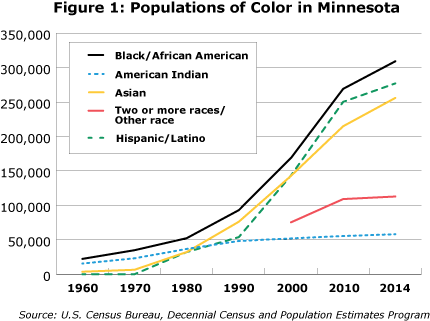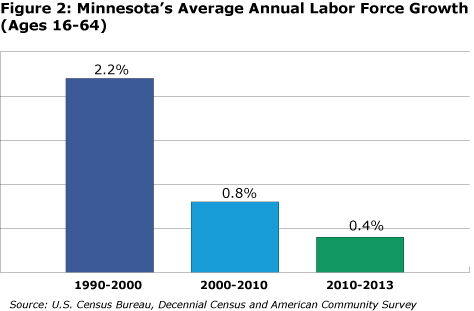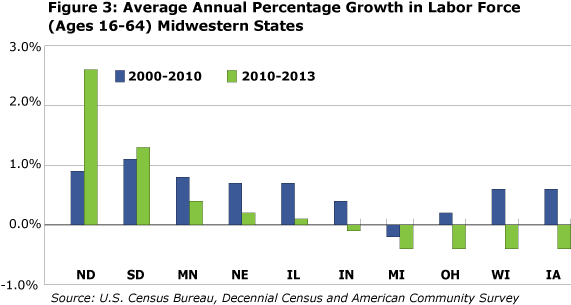by Susan Brower
December 2015
Susan Brower is the Minnesota state demographer and directs the Minnesota State Demographic Center. In those capacities, she travels the state talking with Minnesotans about the new social and economic realities that are brought about by recent demographic shifts. Brower earned her Ph.D. in sociology at the University of Michigan, specializing in demography and family sociology. She also holds a master's degree in public policy from Humphrey School of Public Affairs at the University of Minnesota.
Declining growth in the labor force means we cannot afford to waste the potential of our current and up-and-coming workers.
In 2014, Minnesotans of color.1 made up 19 percent of the state's population and jointly reached a major milestone - topping 1 million residents for the first time. Consider these numbers against 1990, when people of color totaled just 274,000 - a mere 6 percent of the state's population.
Minnesota's non-Hispanic white population has grown little over the same period. In 1990, 4.1 million residents identified as non-Hispanic white, compared with 4.4 million today - an increase of fewer than 350,000 people.
Since 1990, three major race groups have experienced particularly robust growth (see Figure 1). Black Minnesotans now total more than 300,000, while Asian and Latino populations have each grown to more than 250,000. Minnesota residents who identify with two or more race groups surpassed 110,000, up from 75,000 in 2000 when multiple racial identities (categorized as "two or more races") were first measured by the census.

Growth among American Indians has been modest, totaling about 60,000 today. An additional 35,000 American Indians, however, identify themselves as belonging to more than a single race.
Looking ahead, our state's populations of color will continue to be the engine of the population and labor force growth, so their success, or lack of it, will increasingly chart the future for Minnesota.
The growth among racially diverse Minnesotans comes at a critical time for our economy. In the next 15 years, the state is poised to experience a major slowdown in the growth of its labor force as the baby boomers continue to enter their retirement years.
In the 1990s, Minnesota's labor force (ages 16-64) grew by an average of 2.2 percent each year. By the 2000s, growth had fallen to just 0.8 percent annually, and it has slowed even further since 2010 (see Figure 2).

In the next 10 years, as the largest age cohort of Minnesotans - those now in their 50s - moves into retirement, the need for replacement workers to fuel our economy and pay for needed public services will be even greater than it is today.
Minnesota is not alone. The vast majority of states (48) have experienced slower labor force growth rates since 2010 than their average growth in the 2000s. When compared with other Midwestern states2, Minnesota competes rather favorably (see Figure 3). Only North Dakota and South Dakota have outpaced Minnesota in percentage terms. Meanwhile two states (Nebraska and Illinois) have labor forces that have grown more slowly than Minnesota, and the remaining five Midwestern states have seen their workforces actually shrink since 2010.

When we take into account the contribution of workers ages 65 years and older, these numbers are tempered only slightly. Our challenge, then, is widespread and shared across the states, which will serve to intensify the competition for skilled workers. Employers take note: You will have to expend more effort to attract and retain strong candidates.
Put simply, declining growth in the labor force also means we cannot afford to waste any human capital among our current and up-and-coming workers. For decades we have enjoyed a healthy flow of workers to fill available jobs, even during economic downturns. But demography now has its hand on the spigot. We are quickly moving into a reality where workers will be a scarcer commodity relative to jobs, and the growing ranks of former workers of the boomer generation will mean a larger bulge of our total population will reside among our oldest residents.
The large and persistent racial gaps in educational attainment and employment in Minnesota have been well documented and have always been unacceptable in a state that prides itself on opportunity for all. However, Minnesota's demographic context heightens the economic urgency of addressing racial disparities, to backfill the labor force that the boomers are swiftly exiting. Against a backdrop of prolonged, slow labor force growth, we cannot afford to squander the potential of any labor force participant.
1"Minnesotans of color" are those who self-identify as Hispanic/Latino, and/or American Indian, Asian, African American or black, alone or in combination with another race.
2The Midwestern states, as classified by the Bureau of Labor Statistics, are North Dakota, South Dakota, Minnesota, Nebraska, Illinois, Indiana, Michigan, Ohio, Wisconsin and Iowa.